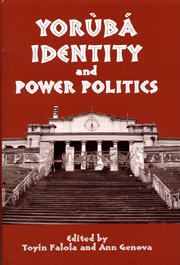Book contents
- Frontmatter
- Contents
- List of Illustrations
- Introduction
- Part I Writing Yorùbá
- 1 The Yorùbá Nation
- 2 Oral Tradition and the Reconstruction of Yorùbá Dress
- 3 Diaries as Cultural and Intellectual Histories
- 4 Historiography of Western Yorùbá Borderlands
- 5 The History of the Okun Yorùbá: Research Directions
- 6 Ìlá Kingdom Revisited: Recent Archaeological Research at Ìlá-Yàrà
- 7 Early Ìjѐbú History: An Analysis on Demographic Evolution and State Formation
- Part II Chiefs and Tradition
- Part III Identity and Modern Politics
- Notes on the Contributors
- Index
4 - Historiography of Western Yorùbá Borderlands
from Part I - Writing Yorùbá
Published online by Cambridge University Press: 12 September 2012
- Frontmatter
- Contents
- List of Illustrations
- Introduction
- Part I Writing Yorùbá
- 1 The Yorùbá Nation
- 2 Oral Tradition and the Reconstruction of Yorùbá Dress
- 3 Diaries as Cultural and Intellectual Histories
- 4 Historiography of Western Yorùbá Borderlands
- 5 The History of the Okun Yorùbá: Research Directions
- 6 Ìlá Kingdom Revisited: Recent Archaeological Research at Ìlá-Yàrà
- 7 Early Ìjѐbú History: An Analysis on Demographic Evolution and State Formation
- Part II Chiefs and Tradition
- Part III Identity and Modern Politics
- Notes on the Contributors
- Index
Summary
Introduction
The Yorùbá culture area is very large, and it traverses several political units. Within this area, one can identify layers of identities such as the reference to a Yorùbá nation, a Yorùbá race, and the Yorùbá diaspora. A. I. Asiwaju illustrates this point by using three concentric rings to describe the Yorùbá culture area. The inner-most ring depicts the core area, beginning from southwestern Nigeria stretching through the southern and central parts of the Republic of Benin and terminating at the Ufe and Atakpame areas of central Togo. The middle ring embraces groups that are related to the Yorùbá by language, culture, and traditions of origin such as the Edo, Itsekiri, Borgu, Igala, and the Aja. I. A. Akinjogbin has widened this middle ring to include the Nupe, the Fon of the Republic of Benin, and the Gaa, Krobo, and Adangbe of modern Ghana. The outer ring, as identified by Asiwaju, is formed by the Yorùbá diaspora communities in Sierra Leone, Cuba, Brazil, Haiti, Jamaica, and other places.
Geographically speaking, Yorùbáland lies between parallels 5.86° and 9.22° north and between 2.65° and 5.72° east. The territory is bounded in the south by the Bight of Benin and shares a boundary with Borgu in the north. In width, Yorùbáland starts from the border of Benin, on the east, and stops at the bank of the River Mono in central Togo.
- Type
- Chapter
- Information
- Yorùbá Identity and Power Politics , pp. 96 - 110Publisher: Boydell & BrewerPrint publication year: 2006



